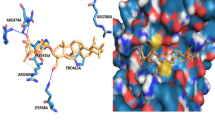Summary
Effective targeting of androgen biosynthesis by the 17α-hydroxylase/17,20-lyase inhibitor abiraterone prolongs survival in a variety of prostate cancer patients. However, resistance to abiraterone treatment occurs frequently and the development of new drugs supporting or complementing abiraterone therapy is urgently needed. We recently reported antiproliferative and proapoptotic effects of hydroxylated polychlorinated biphenyls (PCBs) on various blood cell lines in vitro. Here we report the biological evaluation of the PCB28 derived OH-metabolites 3-OHCB28 or 3′-OHCB28 in prostate cancer cells. Depending on concentration, both metabolites inhibit the growth of PC3 cells, a cell line representing later stages of advanced prostate cancer. In addition 3′-OHCB28 reduced the necessary concentration of abiraterone required for the inhibition of PC3 cells by a factor of 4. Western blot analysis of cytoprotective heatshock proteins (HSP) implicated a significant reduction of HSP27 expression by 3′-OHCB28 in PC3 cells. Given the known HSP27 suppressive role of abiraterone, our results therefore suggest, that that the pharmacological interaction between abiraterone and 3′-OHCB28 in PC3 cells could be produced by the combined effect of both substances on the expression of HSPs, especially the expression of HSP27. Including the known dose response linkages and pharmacokinetic characteristics of the OH-metabolites described here, we conclude, that the use of hydroxylated PCBs can be supportive for the anti-proliferative treatment of prostate cancer and merits further investigation.


Similar content being viewed by others
References
Ziegler S, Schettgen T, Beier F, Wilop S, Quinete N, Esser A, Masouleh BK, Ferreira MSV, Vankann L, Uciechowski P, Rink L, Kraus T, Brümmendorf TH, Ziegler P (2017) Accelerated telomere shortening in peripheral blood lymphocytes after occupational polychlorinated biphenyls exposure. Arch Toxicol 91:289–300. https://doi.org/10.1007/s00204-016-1725-8
Vasko T, Hoffmann J, Gostek S, Schettgen T, Quinete N, Preisinger C, Kraus T, Ziegler P (2018) Telomerase gene expression bioassays indicate metabolic activation of genotoxic lower chlorinated polychlorinated biphenyls. Sci Rep 8:16903. https://doi.org/10.1038/s41598-018-35043-w
Kimbrough RD (1987) Human health effects of polychlorinated biphenyls (PCBs) and polybrominated biphenyls (PBBs). Annu Rev Pharmacol Toxicol 27:87–111. https://doi.org/10.1146/annurev.pa.27.040187.000511
Lauby-Secretan B, Loomis D, Grosse Y, el Ghissassi F, Bouvard V, Benbrahim-Tallaa L, Guha N, Baan R, Mattock H, Straif K, WHO International Agency for Research on Cancer (2013) Carcinogenicity of polychlorinated biphenyls and polybrominated biphenyls. The Lancet Oncology 14:287–288. https://doi.org/10.1016/s1470-2045(13)70104-9
Grimm FA, Hu D, Kania-Korwel I, Lehmler HJ, Ludewig G, Hornbuckle KC, Duffel MW, Bergman Å, Robertson LW (2015) Metabolism and metabolites of polychlorinated biphenyls. Crit Rev Toxicol 45:245–272. https://doi.org/10.3109/10408444.2014.999365
Saupe M, Rauschenberger L, Preuß M, Oswald S, Fussek S, Zimmermann U, Walther R, Knabbe C, Burchardt M, Stope MB (2015) Differential expression of the multidrug resistance 1 (MDR1) protein in prostate cancer cells is independent from anticancer drug treatment and Y box binding protein 1 (YB-1) activity. World J Urol 33:1481–1486. https://doi.org/10.1007/s00345-014-1469-0
Grossebrummel H et al (2016) Cytochrome P450 17A1 inhibitor abiraterone attenuates cellular growth of prostate cancer cells independently from androgen receptor signaling by modulation of oncogenic and apoptotic pathways. Int J Oncol 48:793–800. https://doi.org/10.3892/ijo.2015.3274
Weiss M, Ahrend H, Grossebrummel H, Ziegler P, Brandenburg LO, Walther R, Zimmermann U, Burchardt M, Stope MB (2016) Cytochrome P450 17A1 inhibitor Abiraterone acetate counteracts the heat shock protein 27’s cell survival properties in prostate Cancer cells. Urol Int 97:112–117. https://doi.org/10.1159/000445251
AnvariFar H, Amirkolaie AK, Jalali AM, Miandare HK, Sayed AH, Üçüncü Sİ, Ouraji H, Ceci M, Romano N (2018) Environmental pollution and toxic substances: cellular apoptosis as a key parameter in a sensible model like fish. Aquatic toxicology (Amsterdam, Netherlands) 204:144–159. https://doi.org/10.1016/j.aquatox.2018.09.010
Becker MM, Gamble W (1982) Determination of the binding of 2,4,5,2′,4′,5′-hexachlorobiphenyl by low density lipoprotein and bovine serum albumin. J Toxicol Environ Health 9:225–234. https://doi.org/10.1080/15287398209530157
Ljunggren SA, Helmfrid I, Salihovic S, van Bavel B, Wingren G, Lindahl M, Karlsson H (2014) Persistent organic pollutants distribution in lipoprotein fractions in relation to cardiovascular disease and cancer. Environ Int 65:93–99. https://doi.org/10.1016/j.envint.2013.12.017
Purkey HE, Palaninathan SK, Kent KC, Smith C, Safe SH, Sacchettini JC, Kelly JW (2004) Hydroxylated polychlorinated biphenyls selectively bind transthyretin in blood and inhibit amyloidogenesis: rationalizing rodent PCB toxicity. Chem Biol 11:1719–1728. https://doi.org/10.1016/j.chembiol.2004.10.009
Lans MC, Klasson-Wehler E, Willemsen M, Meussen E, Safe S, Brouwer A (1993) Structure-dependent, competitive interaction of hydroxy-polychlorobiphenyls, −dibenzo-p-dioxins and -dibenzofurans with human transthyretin. Chem Biol Interact 88:7–21
Quinete N, Esser A, Kraus T, Schettgen T (2017) PCB 28 metabolites elimination kinetics in human plasma on a real case scenario: study of hydroxylated polychlorinated biphenyl (OH-PCB) metabolites of PCB 28 in a highly exposed German cohort. Toxicol Lett 276:100–107. https://doi.org/10.1016/j.toxlet.2017.05.025
Funding
This work was supported by a START-grant (AZ 14/16) of the Faculty of Medicine RWTH Aachen University to PZ.
Author information
Authors and Affiliations
Corresponding author
Ethics declarations
Conflict of interest
All the authors declare that they have no conflict of interest.
Ethical approval
This article does not contain any studies with human participants or animals performed by any of the authors.
Informed consent
For this type of study, formal consent is not required
Additional information
Publisher’s note
Springer Nature remains neutral with regard to jurisdictional claims in published maps and institutional affiliations.
Electronic supplementary material
Supplemental Figure 1
3-OHCB28 and 3′-OHCB28 modulate heatshock protein expression in PC3 cells. A + B) Western blot analysis of relative expression of HSP40, HSP60, HSP90α and the Hsp70-Hsp90 organizing protein (HOP) in the presence of 20 μM OHCB28 or 3′-OHCB28 at the indicated timepoints. Data were standardized to vehicle treated cells (control = 1.0) with glyceraldehyde 3-phosphate dehydrogenase (GAPDH) as loading control. Error bars indicate ± SD. *p ≤ 0.05, **p ≤ 0.01 ***p ≤ 0.001, as determined by Student’s t test. (PDF 147 kb)
Rights and permissions
About this article
Cite this article
Daragan, G., Hoffmann, J., Vasko, T. et al. Dirty deeds done dirt cheap: sensitization of prostate cancer cells to abiraterone treatment using hydroxylated polychlorinated biphenyls. Invest New Drugs 38, 541–545 (2020). https://doi.org/10.1007/s10637-019-00833-0
Received:
Accepted:
Published:
Issue Date:
DOI: https://doi.org/10.1007/s10637-019-00833-0




